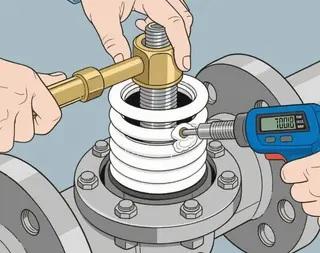How to Determine if Valve Packing Needs Replacement

How to Determine if Valve Packing Needs Replacement
In industrial production, valves are critical for controlling fluid flow, and the packing gland is an essential component for valve sealing. When packing fails, media leakage can occur, affecting production efficiency and potentially causing safety hazards. Timely assessment and replacement of valve packing are therefore vital for maintaining equipment performance.
1. Visual Inspection of Leakage
The most direct method is to observe the packing gland for leakage:
-
Liquid leakage: Dripping or seeping around the valve stem indicates packing failure.
-
Gas leakage: For gaseous media, applying soapy water around the packing gland will reveal bubbles if leakage occurs.
-
Minor leaks: Slight dampness or small droplets may not immediately affect operation but should be monitored.
Severe or continuous leakage, especially in chemical production or safety-critical processes, requires immediate packing replacement.
2. Sensation During Valve Operation
Changes in valve operation can indicate packing issues:
-
Increased operating force: If a valve that previously operated smoothly now feels stiff, the packing may have compacted, aged, or lost elasticity.
-
Uneven stem movement: Sticking, shaking, or inconsistent resistance may result from uneven friction caused by packing wear, damage, or improper installation.
3. Inspection of Packing Appearance and Condition
During maintenance, inspect the packing directly:
-
Hardening or brittleness: Indicates aging or chemical degradation.
-
Discoloration: For example, graphite packing turning grayish-white signals chemical erosion.
-
Wear and thickness reduction: Severely worn packing cannot provide sufficient sealing force.
-
Elasticity test: Press the packing; if it does not return to its original shape, replacement is required.
4. Reviewing Maintenance Records and Service Life
-
Repeated repairs, such as adding packing or adjusting the gland, may indicate that the packing has reached the end of its effective life.
-
Estimate service life based on operating environment: chemical valves may need replacement within a year, while water supply valves may last longer.
5. Other Inspection Methods
-
Seepage tests: Place a clean paper or hygrometer near the valve to detect leakage.
-
Pressure tests: Evaluate sealing performance under operational conditions.
-
Operational feedback: Excessive stiffness, sticking, or poor closure often points to worn packing.
Precautions When Replacing Packing
-
System preparation: Close the valve and drain all media to prevent leaks and hazards.
-
Careful removal: Use packing hooks or appropriate solvents for hardened packing, avoiding damage to the valve.
-
Clean and lubricate the stem: Remove debris and apply appropriate lubricants to reduce friction.
-
Select suitable packing material: Consider temperature, pressure, media type, and valve characteristics. Common materials include graphite, PTFE, and flexible graphite.
-
Proper installation: Install packing rings in a circular manner, tightening gradually to ensure even compression. Avoid over- or under-tightening, which can impair sealing or valve operation.
Conclusion
Accurately determining when valve packing needs replacement ensures reliable valve operation and effective sealing. A combination of visual inspection, operational feedback, maintenance review, and testing should be used for assessment. When replacement is required, careful selection of materials, adherence to installation procedures, and attention to detail are critical for restoring valve performance and preventing operational failures or safety incidents.
It's important to know about Google SEO to help your website rank higher in search results.
- Fashion
- Art
- Causes
- Crafts
- Dance
- Drinks
- Film
- Fitness
- Food
- Jocuri
- Gardening
- Health
- Home
- Literature
- Music
- Networking
- Alte
- Party
- Religion
- Shopping
- Sports
- Theater
- Wellness
